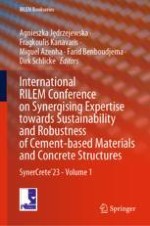2023 | OriginalPaper | Buchkapitel
Monitoring of Capillary Pressure Evolution in Young Age Concrete Using High Capacity Tensiometers
verfasst von : Armin Jamali, Joao Mendes, Brabha Nagaratnam, Michael Lim
Verlag: Springer Nature Switzerland
Aktivieren Sie unsere intelligente Suche, um passende Fachinhalte oder Patente zu finden.
Wählen Sie Textabschnitte aus um mit Künstlicher Intelligenz passenden Patente zu finden. powered by
Markieren Sie Textabschnitte, um KI-gestützt weitere passende Inhalte zu finden. powered by
